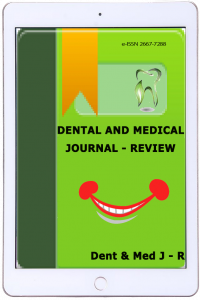Rehberli İmplant Cerrahisi
Dental implantların çene kemiği içerisine uygun konumda yerleşimi, sinir hasarı ve kemik perforasyonu gibi oluşabilecek çeşitli cerrahi komplikasyonları azaltmaktadır. Rehberli implant cerrahisi, implantların çene kemiği içerisine ideal konumda yerleşimlerini sağlamak amacıyla kullanılan bir tedavi yöntemidir. Özetle; dijital planlama, kişiye özel cerrahi rehber üretimi ve implant uygulama aşamalarını ifade eder. Rehberli implant cerrahisi çeşitli basamaklardan oluşan komplike bir tedavi yöntemidir. Bu basamakların her birinde önemli hatalar meydana gelebilir ve meydana gelen hatalardan dolayı uygulanan tedavi olumsuz sonuçlanabilir. Bu makale, rehberli implant cerrahisi hakkındaki bilgileri özetlemekte, her bir adımda oluşabilecek potansiyel riskler ve problemler hakkında fikir vermektedir. Ayrıca bu riskleri en aza indirmek veya ortadan kaldırmak için klinik ile ilgili tavsiyeler sunmaktadır.
Anahtar Kelimeler:
implant, rehberli cerrahi, komplikasyon, CBCT
GUIDED IMPLANT SURGERY
Proper placement of dental implants in the bone reduces various surgical complications such as nerve damage and bone perforation. Guided implant surgery is a treatment method used to ensure that the implants are placed in the jawbone in an ideal position. In summary; digital planning refers to the production of personalized surgical guides and implant application stages. Guided implant surgery is a complicated treatment method consisting of several steps. Important mistakes may occur in each of these steps and the treatment applied may result in negative results due to the errors that occur. This article summarizes the information about guided implant surgery and gives an idea of the potential risks and problems that can occur at each step. It also provides clinical advice to minimize or eliminate these risks.
Keywords:
ımplant, guided surgery, complication, CBCT,
___
- Rosenfeld AL, Mandelaris GA, Tardieu PB. Prosthetically directed implant placement using computer software to ensure precise placement and predictable prosthetic outcomes. Part 2: rapid‐prototype medical modeling and stereolithographic drilling guides requiring bone exposure. Int J Periodontics Restorative Dent. 2006;26(4):347‐353.
- Arisan V, Karabuda CZ, Ozdemir T. Implant surgery using bone and mucosa‐supported stereolithographic guides in totally edentulous jaws: surgical and post‐operative outcomes of computer‐aided vs. standard techniques. Clin Oral Implants Res. 2010;21(9):980‐988.
- Vercruyssen M, van de Wiele G, Teughels W, Naert I, Jacobs R, Quirynen M. Implant‐ and patient‐centred outcomes of guided surgery, a 1‐year follow‐up: an RCT comparing guided surgery with conventional implant placement. J Clin Periodontol. 2014;41(12):1154‐1160.
- Ozan O, Turkyilmaz I, Ersoy AE, McGlumphy EA, Rosenstiel SF. Clinical accuracy of 3 different types of computed tomographyderived stereolithographic surgical guides in implant placement. J Oral Maxillofac Surg. 2009;67(2):394‐401.
- Tahmaseb A, Wismeijer D, Coucke W, Derksen W. Computer technology applications in surgical implant dentistry: a systematic review. Int J Oral Maxillofac Implants. 2014;29(Suppl):25‐42.
- ISSN: 2667-7288
- Yayın Aralığı: Yılda 3 Sayı
- Başlangıç: 2019
- Yayıncı: Mesut TUZLALI
Sayıdaki Diğer Makaleler
TÜRKİYE KAYNAKLI HEPATİT E VİRUS SEROPREVELANS ÇALIŞMALARININ GÖZDEN GEÇİRİLMESİ
Sevil ALKAN, Nur CANCAN GÜRSUL, Taylan ÖNDER
Tromboangitis obliterans (Buerger Hastalığı)
HEMATOLOJİ PERSPEKTİFİNDEN BRUSELLOZ
PERİODONTAL HASTALIK VE COVID-19 ARASINDAKİ İLİŞKİ MEKANİZMALARI
PERİODONTAL VE SİSTEMİK HASTALIKLAR: BİLİŞSEL BOZUKLUKLAR
Hasan HATİPOĞLU, Sibel CANBAZ KABAY
Diş hekimliğinde COVID-19'a karşı geleneksel ağız gargaralarının potansiyel rolü
A.f.m. Shakilur RAHMAN, Tamiral JANNAT
